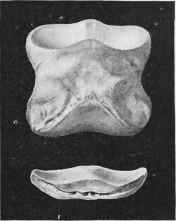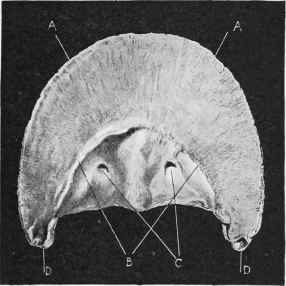Os Pedis (Figs 306, 307), Coffin-Bone, Or Third Phalanx
Description
This section is from the book "The Horse - Its Treatment In Health And Disease", by J. Wortley Axe. Also available from Amazon: The Horse. Its Treatment In Health And Disease.
Os Pedis (Figs 306, 307), Coffin-Bone, Or Third Phalanx
The coffin-bone is contained in the hoof, of the shape of which it in a large measure partakes. It is a porous bone, having a number of holes in its front and sides for the passage of blood-vessels, and is besides generally roughened for the attachment of the sensitive laminae. A pointed process (coronal process) projects upward from the superior border in front, which affords attachment for the tendon of the extensor pedis muscle.

Fig. 305. - Os Coronae and Os Naviculare (Anterior Aspect).

Fig. 306. - Os Pedis (Plantar Aspect).
A, A Inferior Border. B Semilunar Crest. c Plantar Foramina. D, D Retrossal Processes.
The under surface is concave, and presents (1) a crescentic ridge (semilunar crest) to which the tendon of the flexor pedis is attached; (2) behind this two considerable openings (plantar foramina), through which pass the plantar arteries and nerves; (3) still farther back a roughened surface, to which the inferior ligament of the navicular bone is connected. The upper surface is divided by a slight ridge into two shallow cavities, with which the lower extremity of the coronet bone articulates. At the posterior border of this surface a narrow, smooth, transverse space is provided for the articulation of the navicular bone with the foot - bone. Projecting backward from the inferior border behind are two bony processes, one on either side, termed aloe, or wings.
Continue to:


